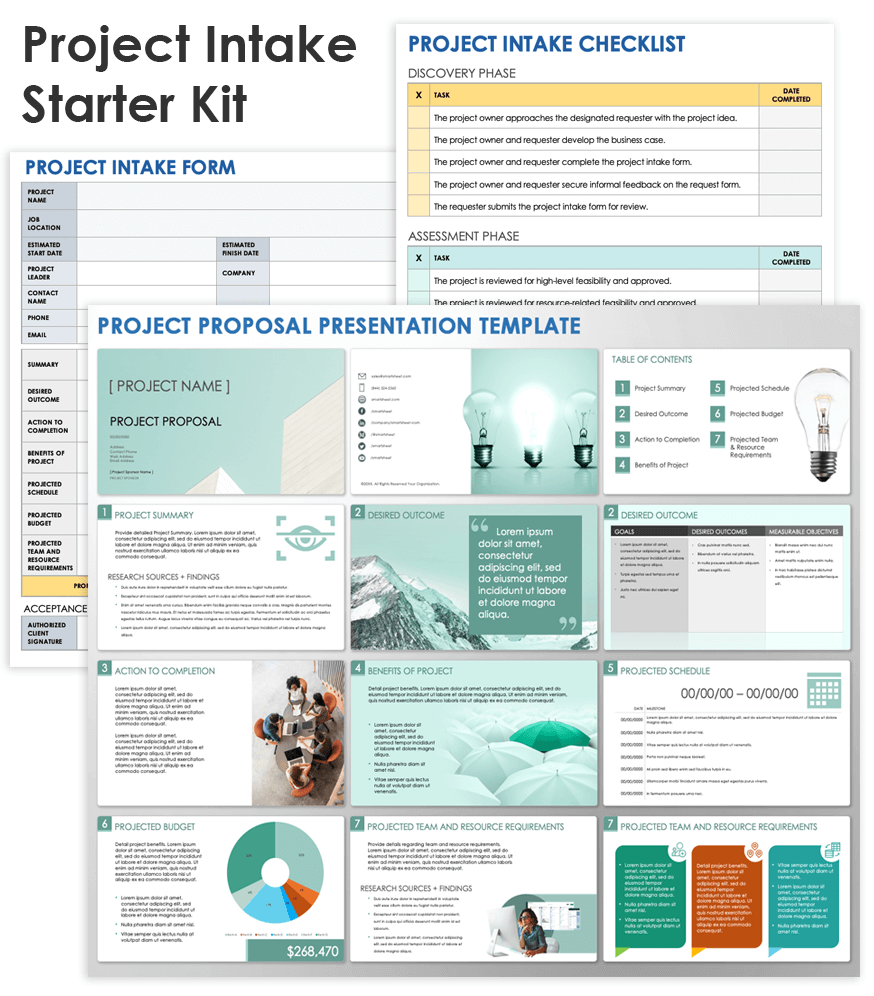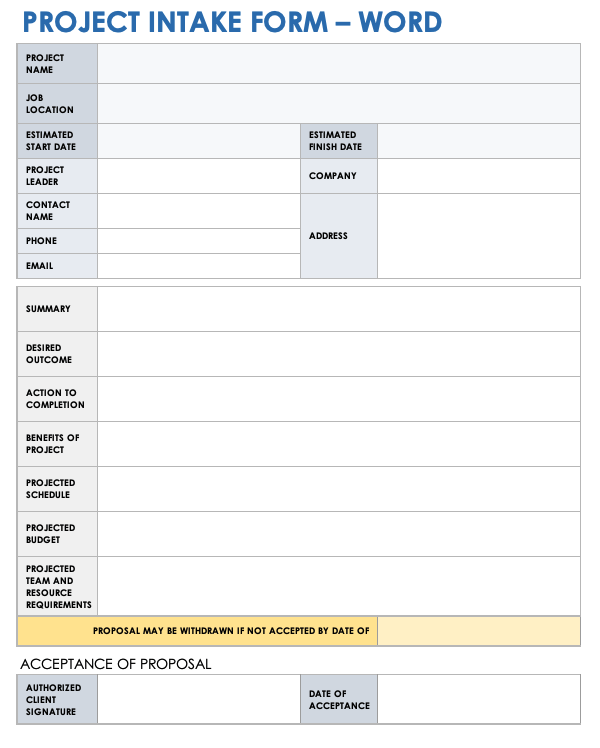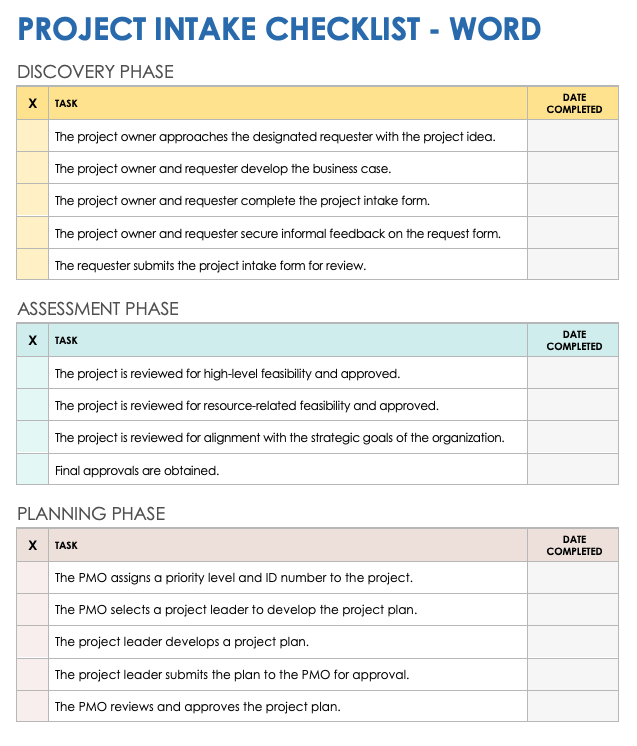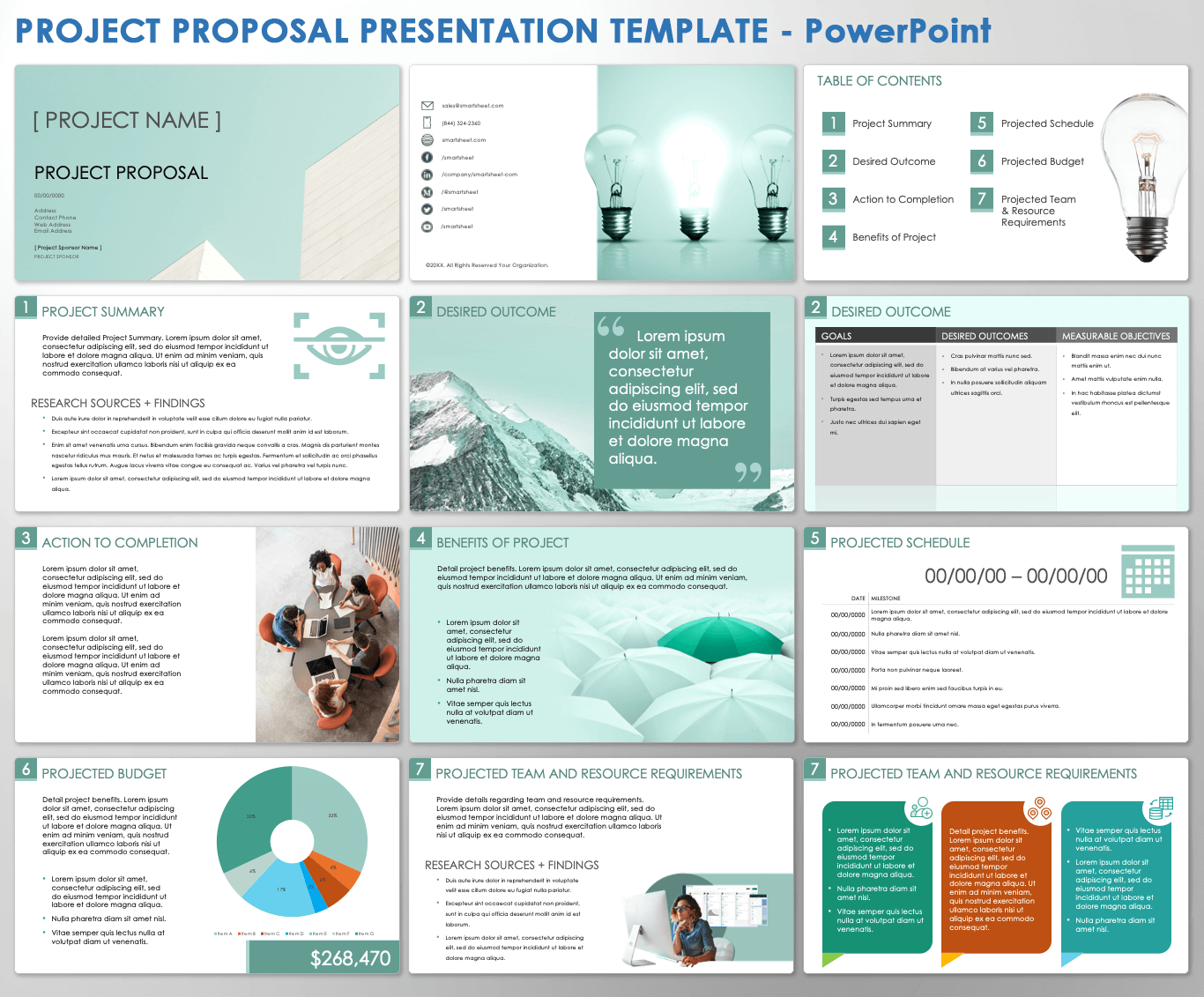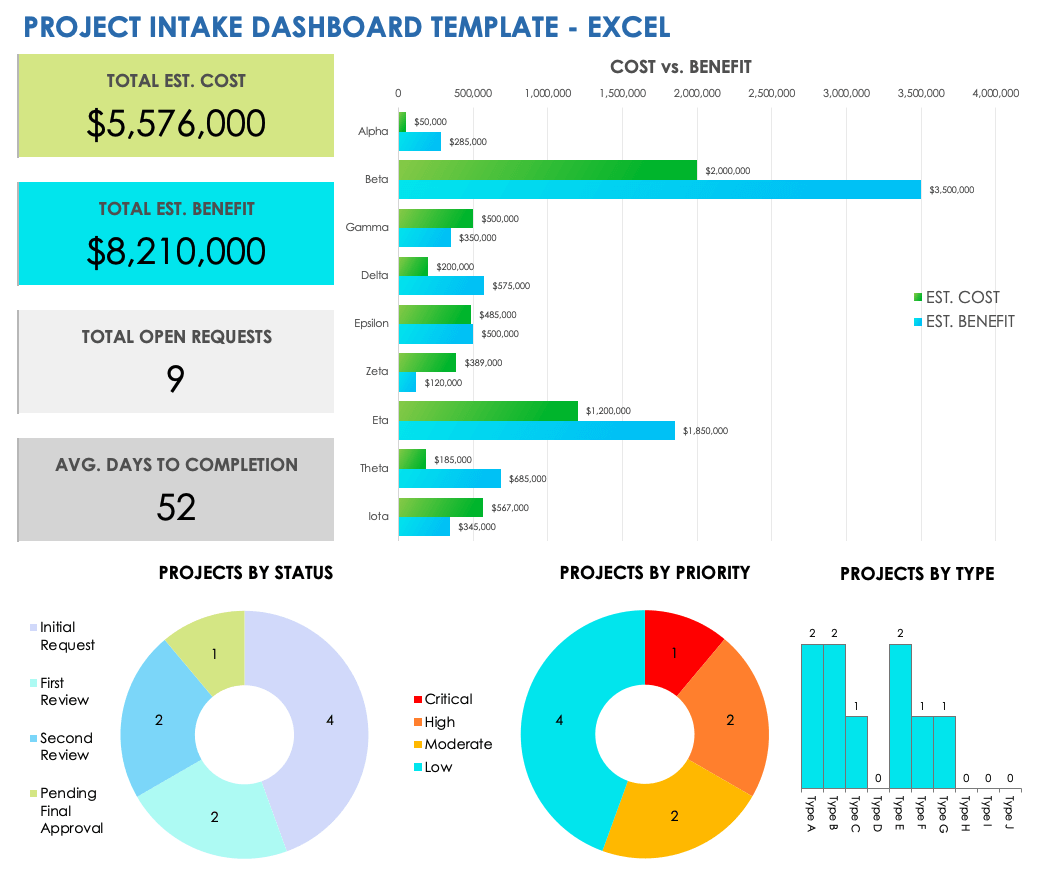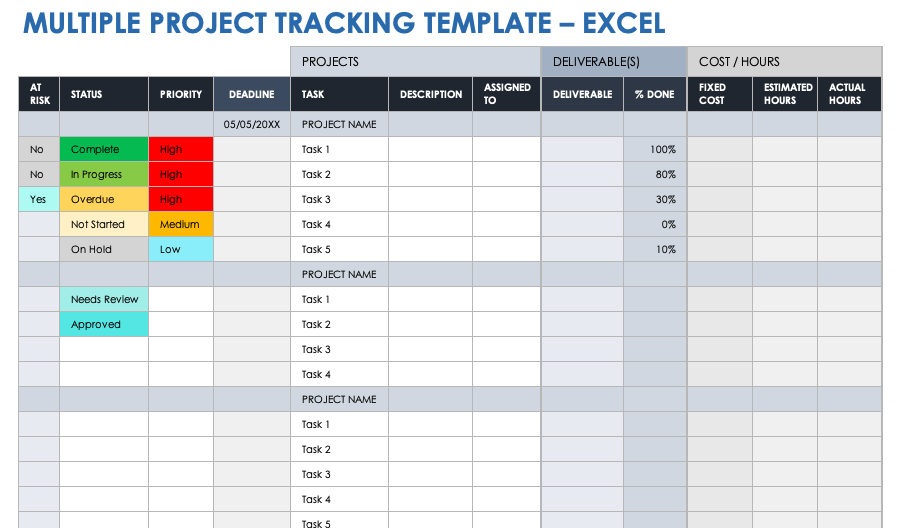What Is a Project Intake Process?
A company uses a project intake process to keep project requests organized. It provides a structure for submitting and reviewing project requests. Use a work intake process to sort out small work requests.
The goal of a project intake process is to improve the strategic value of the entire organization. Imagine a company that has no standardized process for submitting or reviewing project requests. Team members might submit requests over email, in company chat rooms, or verbally. In this scenario, company leaders will inevitably ignore or lose some requests. When they do review these project requests, they have no clear metrics for judging the project’s urgency, feasibility, or alignment with organization-wide strategy.
When you have a functional project intake process, everyone understands who submits requests, where to submit them, and what information to include. In addition, it is clear who reviews the proposals, when and how they review them, and who can give final approval.
In order to establish a project intake process, it must be clear what a project is. A project might have a specific dollar, time, or effort threshold. Work orders that fall below this threshold, usually simple tasks such as IT tickets, can be automated with a work intake process.
“The difference between a project intake process and a work intake process is the complexity of the request and prerequisites or dependencies of the request,” says Samantha Crunkilton, Catalog Content Manager for Cheetah Technologies. “If it’s a simple task that can be assigned to a team member and resolved, it is a work intake process. If it requires additional information, a project scope, buy-in from other stakeholders, or funding to complete, it is a project intake process.”
Organizations might also choose to have separate intake processes for internal and external project requests.
Why Do You Need a Project Intake Process?
A project management office (PMO) will use a project request process to allocate work fairly and efficiently. A standard intake process will also help managers keep projects aligned with larger strategic goals across an organization.
David Farkas, Founder and CEO of The Upper Ranks, stresses the importance of creating a project intake process: “Some of the reasons why we need this intake process are to provide a single point of contact for all project and work requests, both internal and external; to formally sanction initiatives; to keep track of all job assignments and project ownership; to assess and document the team's contribution in the context of the organization; and to guarantee that projects are prioritized effectively and delivered on schedule and with high quality, and that work is distributed fairly within the team.”
A project intake process can also be a useful diagnostic tool to locate resource gaps, measure each team’s contribution to the business, and identify trends and patterns. Management can use this information to establish better training programs, promote departmental self-sufficiency, and conduct an impact analysis.
By implementing an intake process, project and program managers can streamline work, which ultimately reduces their own workloads. This is why project intake processes are common in all industries, including government, IT, marketing, human resources, healthcare, and construction.
It’s time to set up a project intake process or revamp your current process if you notice that some or all of the following cases apply to you:
- Your organization is large enough that it is difficult to keep track of multiple projects.
- Project requests are coming through multiple channels, such as email, chat rooms, and in-person meetings.
- Requests are pending for long periods of time.
- Requesters have no way to check in on the status of their requests.
- Projects are shortsighted and do not account for larger, organizational goals.
- Disputes arise over who can approve projects.
Benefits of Having a Project Intake Process
A good project intake process means more consistency and transparency. When everyone understands the intake process, participation, efficiency, team cohesion, oversight, and proposal quality improve. You also reduce the risk of scope creep.
These are some benefits you can expect from establishing a clear project intake process:
- Better Organization: A single, centralized hub where requesters submit all intake forms makes it easier to keep requests organized and harder to lose or misplace them. “Everything is documented, so any changes or issues that arise have backup to reference later,” says Crunkilton.
- More Opportunities: When there is a clear project intake process, team members are more likely to bring forward good ideas that they might not have otherwise. As a result, promising project ideas don’t slip through the cracks.
- Increased Efficiency: Project request processes shorten the time between project proposals and approvals, and they reduce the number of people who need to review a proposal. Tools and templates, such as project request forms, also make proposals easy to review and compare. “An official submission process ensures that all requests are received and reviewed, and a decision can be made on next steps,” says Crunkilton.
- Higher-Quality Proposals: Specifying what information is most important helps teams to submit better proposals. They are less likely to waste time collecting unnecessary data.
- Better Strategic Alignment: By standardizing the criteria for evaluating requests, company leaders can ensure that projects serve the strategic needs of the organization. “Your project assessment, planning, and execution processes are all consistent from one phase to the next,” explains Farkas. “It’s tough to keep a healthy portfolio when project acceptance criteria rely on getting clearance from an executive. This occurs when there is no established procedure or checklist. Agreeing on intake criteria assists in avoiding making rash or surprising decisions.”
- Better Oversight: Project request management processes can help a project management office (PMO) keep track of all work in progress. It can also help governance teams better control the amount of work in a portfolio.
- Improved Morale: Unclear processes cause misunderstandings, disagreements, and general frustration. A clear project intake process can improve team cohesion and morale. “One major benefit from setting up a solid project intake process is that the team does not get stressed about not knowing what to work on,” says Crunkilton. “Requests can be reviewed, prioritized, and assigned in a systematic manner with a solid process.”
- Reduced Scope Creep:
- One of the most common reasons projects fail is due to scope creep. As David Patterson-Cole, Co-Founder of Moonchaser, explains, “With a project intake process, the first question you're answering is whether the project is worth undertaking or under what parameters. That means you have a better chance of success with product delivery and more clarity on what you need to complete the project. You're also getting improved communication and better transparency right off the bat, which helps keep costs and timelines accurate.”
How to Create a Project Intake Process
The three phases of a project intake process are discovery, assessment, and planning. Create a project intake process phase by phase. Think about who needs to approve projects. Also consider what project-related information is relevant to your company.
Follow along with an existing project intake process, or map your own process with a workflow diagram. When designing a project request process, be sure to identify each team or individual who needs to review a project before it can be greenlit.
You might consider creating different processes for different types of requests. For example, an internal project request will look different than an external project request from a client. Another option is to set up different processes for projects with different budgets or effort thresholds. For projects that are quick or inexpensive, intake processes can require fewer approvals. Expensive or long-term projects might require additional approval steps.
Jami Yazdani, Founder and Chief Consultant at Yazdani Consulting and Facilitation, recommends finding clarity about why you are implementing an intake process before you begin. “Will it be used to approve projects? Plan resource allocations? Gather requirements to streamline project planning and kickoff? Let your purpose drive your process design and the information you will capture,” she says.
These are the phases of the project intake process and what to consider as you design your own:
Discovery Phase
The discovery phase, also called the proposal phase, involves creating a clearly defined process for submitting project requests.
When designing the discovery phase, be sure to define roles. Who can submit requests? To whom should they submit them? No matter the answer, everyone should know these roles. There should also be a single, centralized location to submit all requests.
Consider what parts of this process, if any, can be automated. Can you set up automatic notifications for reviewers every time an intake form is submitted? Also consider setting up a regular time for submitting or reviewing requests. For example, you might set up a regular, weekly meeting for intake reviews. If the meeting is every Thursday, requesters will know to submit requests by Wednesday if they want a quick response.
The discovery phase is also the phase during which project requesters fill out the project intake form.
Assessment Phase
The assessment phase of the project intake process is when requesters secure necessary approvals. During this phase, multiple teams and individuals review intake forms, then reject, put on hold, return to the project owner, or approve the request.
This phase will vary greatly from company to company. When designing the assessment phase, think about what details need to be hammered out before you can greenlight a project. Create a list of departments or individuals who should be responsible for approving elements, such as resource allocation, strategic alignment, or feasibility. Some organizations might include a review step for IT security or legal issues.
Planning Phase
The planning phase is the final phase of a project intake process. During this phase, the project owner transitions the proposal from an idea to an active project.
Once the project is greenlit, it’s time to get the project ready for kickoff. This process could include allocating resources, budgeting, assigning a project manager, assembling a team, and developing a project plan.
At this phase, someone should enter the project into a portfolio of active projects for regular monitoring. You might also consider automating this step.
Steps in the Project Intake Process
A project intake process begins with an idea and ends with a project plan. Most intake processes cover the same basic steps: develop the idea, obtain approvals, and plan the project. Modify these steps to reflect your organization’s needs.
Though intake processes vary by organization, these are the basic steps to follow:
1. Project Idea
The project owner, also called the business owner or initiator, has an idea for a project. They approach the individual responsible for submitting requests.
2. Idea Development
The project owner works with the requester to develop the idea and make a business case. How will this project save time, add value, or mitigate risk? Gather feedback from multiple team members.
3. Intake Form
Once the team has conducted preliminary research, the requester should fill out a standardized project intake form and submit it for review. If the request is urgent, then the form should indicate that status and the response-needed-by date.
4. First Review
The first review team, often the PMO, reviews the request for high-level feasibility. If there is missing information or red flags, they might send the form back to the requester for revisions. They might also reject the proposal outright. If they approve the project, they will submit it to a second team for review.
5. Second Review
Once approved by the first team, a second team will review the project. This might be a resource manager or service owner who considers the project’s resource-related feasibility. They can either send the form back to the business owner to make adjustments, reject the proposal, or approve and submit it to additional teams for review.
6. Additional Reviews
The number of teams that need to review the project will differ among organizations. Usually, the final review happens with a steering committee or a vice president, chief financial officer, or other high-level executive. This committee or individual reviews the proposal for its alignment with larger organizational goals. They can either send the form back to the business owner to make adjustments, reject the proposal, or provide final approval.
7. Priority Level Assignment
Once a project proposal has received all necessary approvals, it goes back to the PMO. The PMO assigns the project a priority level, unique identification number, and project leader.
8. Project Plan
The project leader develops a project plan and submits it to the PMO for approval.
9. Project Execution
Once the project plan is approved, project execution begins.
Below is an example project intake workflow diagram for a two-step approval process, in which the PMO conducts the first review and a steering committee conducts the second.
Project Intake Management
Once an organization has a project intake process in place, it will need tools and strategies to manage project requests. Experts suggest using dashboards, setting up automatic alerts, and clearly defining roles.
“Our company uses a dashboard to manage our project intake process,” says Farkas. “After the intake form is filled out, the project is assigned to the relevant department head. The department head then assigns it to the employee they see fit, and it becomes their responsibility as the project lead. They are allowed to engage a few other employees from different teams based on their availability. This is how they manage to go through the process without letting anything fall through the cracks.”
In addition, Yazdani recommends building your intake process on established processes to make management easier. “Take advantage of existing platforms and systems to manage your intake process,” suggests Yazdani. “Creating and managing your form in your organization's project management or team collaboration tool makes it easier to integrate your process into other workflows and view submission data alongside other relevant dashboards.”
Project Intake Process Best Practices
Experts’ advice for a project intake process include documenting workflows, conducting audits, and using project management tools. These steps will help you create an effective process.
With the help of experts, we’ve compiled this list of project intake process best practices to keep in mind:
- Specify Clear Process Ownership: Whether it’s a project management office or a program manager, there should be a clear owner of the project intake process. This team or individual is responsible for ensuring that the process stays current and functional. They will also provide all necessary training. “The roles and responsibilities of each person in the process must be documented and communicated,” says Farkas.
- Document Your Workflow: Always have a clear workflow for your intake process. “The work intake process does not need to be sophisticated, but a standard procedure must be documented,” explains Farkas.
- Create Clear Documentation: Clearly document every step of the process so that everyone in the organization can understand how and why decisions are made. “Document everything,” says Patterson-Cole. “If it's discussed, get it down in writing. Even the small details can become headaches down the road when they're not documented.”
- Use Project Management Tools: Dozens of project management tools and methodologies are available for designing your intake request process. They can provide structure and help you create a process that’s aligned with how your company operates.
- Identify Essential Information: It should be clear to all requesters exactly what information they need to acquire before submitting their formal project request. When you design your project intake form, Yazdani recommends preempting information that will become important later. “Request enough information to make decisions about a project, but also capture information that will be useful at a project kickoff, such as key stakeholders and initial scope,” she says.
- Determine Project Proposal Thresholds: Not every project is expensive or complicated enough to warrant an extensive intake process. Farkas suggests defining project types and crafting intake processes to match. “In most circumstances, companies must begin with project requests,” he explains. “Creating these definitions will help verify that all requests match the project definition.”
- Keep Project Requests Centralized: Provide one centralized location where team members send all project requests. When requests begin to come through multiple channels, that’s a good indication that your project intake process is not functional.
- Conduct Regular Audits: The only way to ensure a process stays effective is to make incremental improvements and address problems as they arise. “Keep building on the process based on feedback and lessons learned,” suggests Crunkilton.
- Integrate with Other Processes: No process exists in a vacuum. “Tie project intake to your project assessment or retrospective process to assess the full impact of your projects,” advises Yazdani.
- Establish a Clear Process Timeline: Keep the timeline between intake form submission and project approval consistent. What day of the week should proposals be submitted for timely review? Can you set up a standing meeting for proposal reviews? The more predictable and reliable this timeline, the more smoothly your intake process will function.
- Conduct Beta Testing: Before you implement any process, you’ll need to ensure that it functions properly. “Always do beta testing,” says Farkas. “It allows you to catch mistakes before the intake process goes live and you get complaints. Be it load testing or something else, everything has to be beta tested beforehand.”
What Is a Project Intake Form?
A project intake form is a questionnaire that acts as a formal request for a project. A requestor uses this form to share key project information. An intake form includes a project’s urgency, business case, and estimated budget and timeline.
When designing a project intake form, think about what information is most essential to the decision-making process. The temptation is to create a detailed form with as much info as possible, but overly complicated intake forms are actually counterproductive. Winnow down information to the most important fields to avoid wasting time.
Although project intake forms vary, consider including some of these common fields:
- Background: Provide context. What is the current status of the problem the project will address or the process it will improve?
- Business Case: Make a short, concise argument for this project. Does the project seize on a growth opportunity, or does it address a specific problem?
- Estimated Benefit: Estimate the total, quantifiable benefit of the project.
- Estimated Cost: Estimate the total cost of project implementation.
- Goals: Include tangible, quantifiable project goals.
- Initiator Name: Include the name of the individual making the request. This role is also called the business owner or project leader.
- Market Definition: Outline relevant trends and insights you’ve identified from market research, and give the reader a sense of the competitive landscape.
- Product Information: Describe the features and added value of the product your project will create.
- Required Resources: List any human, natural, or capital resources required to complete the project.
- Risks: Acknowledge risks that might interfere with the project’s success.
- Sponsor: Include the name of the person sponsoring the project.
- Stakeholders: List any stakeholders impacted by the project’s completion.
- Urgency: Indicate if a project is high, medium, or low urgency. Include a deadline.
Remember to only include fields that are relevant to your organization. For a project intake form template, see this downloadable project intake starter kit.
Best Practices for Completing a Project Intake Form
When filling out a project intake form, be sure to include accurate and relevant data. Avoid wasting time by gathering unnecessary details. Prevent process delays by completing all required fields.
Keep these best practices in mind when completing a project intake form:
- Keep Your Business Case Concise: A business case is like an elevator pitch. Boil down your justification for the project to a sentence or two. For help crafting a successful business case, see this guide to writing business cases.
- Be Honest About Risks: “Be transparent about any project risks or potential challenges, and provide realistic ranges or estimates,” suggests Yazdani. “Inaccurate data, exaggerated metrics, and unattainable timelines will only create problems once a project is underway.”
- Conduct Research: Take the time to gather relevant research, data, and analysis. A project is more likely to be greenlit if the approving parties can see hard numbers and facts that support your business case.
- Keep Your Reviewers in Mind: How you fill out your intake form will depend on who will be reviewing the form. “Craft your responses with the reviewer(s) in mind. What do they need to know to make a decision or take action on your project? What are their preferences for the depth and conciseness of responses?” says Yazdani.
- Seek Feedback: Before submitting your official intake form, ask for a review by a few trusted team members and colleagues. They might catch mistakes or problems.
- Stick to Required Information: Don’t waste time collecting information that isn’t required. There will be time later, during the planning phase, to flesh out more granular project details.
Project Intake Starter Kit
Find everything you need to create and manage a project intake process with this project intake starter kit. The kit includes a project intake form template, a project proposal presentation template, and a project intake checklist all in one easy-to-download file.
Project Intake Form
Download Project Intake Form
Microsoft Excel
|
Microsoft Word
|
Adobe PDF
| Google Docs
Ensure that project requests capture all necessary information with this project intake form. The form includes fields where you can record requester contact information, project name, summary, expected outcome, projected budget, and more. Approvers can sign and date the intake form upon acceptance. Use this form as is, or update the fields to reflect the needs of your organization.
For more form resources, see this comprehensive list of free, downloadable project intake forms and templates.
Project Intake Process Template
Download Project Intake Process Template
Use this fully customizable project intake process template to map your project intake workflow. The template comes with a pre-designed process, which includes a project owner, a project management office (PMO), and a steering committee. Change these roles to match those in your organization, or add and remove roles as necessary. Copy images from the key sheet and paste them into your diagram to add extra steps to your process.
Project Intake Checklist
Download Project Intake Checklist
Microsoft Word
|
Adobe PDF
| Smartsheet
Keep track of all steps in your project intake process with this checklist. The checklist includes every step of a typical project intake process and divides them into three categories: discovery, assessment, and planning. Download the template as an Adobe PDF, or customize the document in Microsoft Word to add more development, approval, or planning steps.
Project Proposal Presentation Template
Download Project Proposal Presentation Template
Microsoft PowerPoint
| Google Slides
For some organizations, project requesters present their proposals as part of the intake process. Use this project proposal presentation template to help create a deck for your project request. The slides include all key details for a project intake process, including project summary, expected benefits, anticipated timeline, and more.
Project Intake Dashboard Template
Download Project Intake Dashboard Template
Microsoft Excel
| Google Sheets
Manage a high volume of project requests with this project intake dashboard template. View all pending requests in one location, and track requests by urgency, estimated cost versus benefit, and project type. The dashboard automatically populates with visually dynamic graphs and charts so that you can get a quick overview of pending project requests.
Multiple Project Tracking Template
Download Multiple Project Tracking Template
Microsoft Excel
| Google Sheets | Smartsheet
In order to establish a successful project intake process, a company needs a way to manage their portfolio. Use this multiple project tracking template to keep your projects organized, to avoid taking on redundant projects, and to keep projects aligned with the strategic goals of your business. The template allows you to track the status, priority, and deadlines of all your projects in one convenient location.
Measuring the Success of Your Project Intake Process
Solid project request management will help you measure the success of your project intake process. Use defined metrics to capture the success of your process. Signs of a successful process include a fast turnaround time and consistent company-wide use.
According to experts, use these reliable strategies to measure the success of your project intake process:
- Consistent Use: Employees will use a successful project or work intake process consistently. “If it is only used some of the time, a part of the process is not allowing it to work efficiently,” says Crunkilton.
- Employee Satisfaction: A functioning process can make most work enjoyable. “This may sound unusual, but if you're enjoying the project intake process — maybe even having fun with it — then you're actually more likely to succeed,” says Patterson-Cole. “If it feels like a drag and you just want to get through the ordeal, that's a sign that things aren't working. There's probably some future dread building up and undermining your ability to do the work. Keep things fairly light but be process-oriented.”
- Fast Turnaround Time: Track the average time between proposal submission and final approval for a quantitative measure of success. “Moving through the process efficiently as expected based on the process is a great way to measure success of the process,” says Crunkilton.
- Healthy Project Portfolio: A growing, diverse project portfolio is a good indication that your process is working. Review the metrics of your project portfolio to get a sense of your project intake process success.
- Positive Feedback: A simple way to measure success is to request feedback. “The best qualitative measure of a successful project intake process is team and stakeholder feedback,” says Crunkilton. “Asking what is working and what isn’t is a great way to determine the success of a process.”
- Strategic Alignment: A project intake process should improve the strategic value of the entire company. “The best measures of success are whether your project intake process supports strategic alignment and organizational agility,” says Yazdani. “Does your process provide decision-makers with enough information to assess whether projects will support your strategic priorities? Do you have a project pipeline to pull from when resources or circumstances change?”
Automate Your Project Intake Process with Smartsheet
Empower your people to go above and beyond with a flexible platform designed to match the needs of your team — and adapt as those needs change.
The Smartsheet platform makes it easy to plan, capture, manage, and report on work from anywhere, helping your team be more effective and get more done. Report on key metrics and get real-time visibility into work as it happens with roll-up reports, dashboards, and automated workflows built to keep your team connected and informed.
When teams have clarity into the work getting done, there’s no telling how much more they can accomplish in the same amount of time. Try Smartsheet for free, today.




